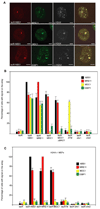Activation of the cellular DNA damage response in the absence of DNA lesions
- PMID: 18483401
- PMCID: PMC2575099
- DOI: 10.1126/science.1159051
Activation of the cellular DNA damage response in the absence of DNA lesions
Abstract
The cellular DNA damage response (DDR) is initiated by the rapid recruitment of repair factors to the site of DNA damage to form a multiprotein repair complex. How the repair complex senses damaged DNA and then activates the DDR is not well understood. We show that prolonged binding of DNA repair factors to chromatin can elicit the DDR in an ATM (ataxia telangiectasia mutated)- and DNAPK (DNA-dependent protein kinase)-dependent manner in the absence of DNA damage. Targeting of single repair factors to chromatin revealed a hierarchy of protein interactions within the repair complex and suggests amplification of the damage signal. We conclude that activation of the DDR does not require DNA damage and stable association of repair factors with chromatin is likely a critical step in triggering, amplifying, and maintaining the DDR signal.
Figures




References
Publication types
MeSH terms
Substances
Grants and funding
LinkOut - more resources
Full Text Sources
Other Literature Sources
Research Materials
Miscellaneous

